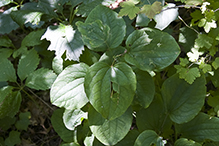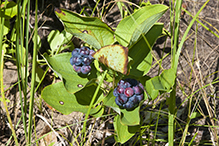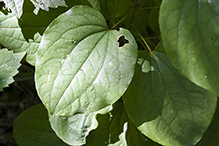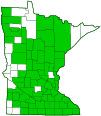upright carrionflower
(Smilax ecirrhata)
Conservation • Description • Habitat • Ecology • Use • Distribution • Taxonomy
Conservation Status |
|
|||||||
| IUCN Red List | not listed |
|||||||
| NatureServe | NNR - Unranked SNR - Unranked |
|||||||
| Minnesota | not listed |
|||||||
Description |
||
Upright carrionflower is a 12″ to 36″ tall, erect to leaning, perennial forb that rises from a rhizome. It is not a vine. The stems are annual, unbranched, and green, not woody. They are not armed with bristles or prickles. They may have a few short tendrils or no tendrils at all. They do not climb. There are usually 7 to 9 leaves, though there may be as many as 20. The leaves on the lower portion of the stem are reduced to triangular, leaf-like bracts. The principal leaves are alternate and are more or less crowded at the end of the stem. They are on thin leaf stalks that are shorter than the leaf blade. The leaf blade is thin, broadly egg-shaped to almost round, 3½″ to 4¾″ long, and 2″ to 3½″ wide. They are rounded at the tip, sometimes with a short, sharp, abrupt tip, and heart-shaped at the base. The upper surface is green and hairless with 3 to 7 conspicuous veins that arch from the base of the leaf blade and converge toward the tip. The lower surface is light green or grayish-green, is not glaucous, and is covered with minute, white, flattened hairs. The margin has scattered, minute, tooth-like projections. The margin is not thickened or lobed. The inflorescence is 1 to 3 globe-shaped, umbrella-like clusters (umbels) rising from the axils of bracts on the lower, leafless portion of the stem. Each umbel has 8 to 25 flowers and is on a 2″ to 4″ long stalk. Each flower has 3 green to yellowish-green, strap-shaped petals and 3 similar sepals (6 tepals). The male flower has 6 stamens with yellow anthers. The flowers appear in late May to late June. The fruit is a purplish-black, globular berry, ⅜″ to 7 ⁄16″ in diameter. It is usually not glaucous at maturity. |
||
Height |
||
12″ to 36″ |
||
Flower Color |
||
Green to yellowish-green |
||
Similar Species |
||
Habitat |
||
Woods |
||
Ecology |
||
Flowering |
||
May to June |
||
Pests and Diseases |
||
|
||
Use |
||
|
||
Distribution |
||||
|
Sources |
|||
| 3/3/2023 | ||||
Nativity |
||||
Native |
||||
Occurrence |
||||
Common |
||||
Taxonomy |
|||
| Kingdom | Plantae (Plants) | ||
| Division | Tracheophyta (Vascular Plants) | ||
| Subdivision | Spermatophytina (Seed Plants) | ||
| Class | Liliopsida (Monocots) | ||
Order |
Liliales (lilies, supplejacks, and allies) | ||
Family |
Smilacaceae (greenbrier) | ||
Genus |
Smilax (greenbriars) | ||
| Section | Nemexia | ||
There are two distinct groups within the genus Smilax. One group, section Nemexia, has herbaceous unarmed stems that die back to the ground each year. The second group, section Smilax, has woody perennial stems with thorns. Plants in the former group, including upright carrionflower, were formerly classified in the genus Nemexia, which is now considered invalid. |
|||
Synonyms |
|||
Nemexia ecirrata |
|||
Common Names |
|||
greenbriar upright carrion-flower upright carrionflower |
|||
Glossary
Axil
The upper angle where a branch, stem, leaf stalk, or vein diverges.
Bract
Modified leaf at the base of a flower stalk, flower cluster, or inflorescence.
Rhizome
A horizontal, usually underground stem. It serves as a reproductive structure, producing roots below and shoots above at the nodes.
Sepal
An outer floral leaf, usually green but sometimes colored, at the base of a flower.
Tepal
Refers to both the petals and the sepals of a flower when they are similar in appearance and difficult to tell apart. Tepals are common in lilies and tulips.
Umbel
A flat-topped or convex, umbrella-shaped cluster of flowers or buds arising from more or less a single point.
Visitor Photos |
|||||
Share your photo of this plant. |
|||||
| This button not working for you? Simply email us at info@MinnesotaSeasons.com. Attach one or more photos and, if you like, a caption. |
|||||
Luciearl |
|||||
 |
 |
||||
MinnesotaSeasons.com Photos |
|||||
Plant |
|||||
 |
 |
||||
Leaves |
|||||
 |
 |
||||
Infructescence |
|||||
 |
|||||

Slideshows |
||

Visitor Videos |
|||
Share your video of this plant. |
|||
| This button not working for you? Simply email us at info@MinnesotaSeasons.com. Attach a video, a YouTube link, or a cloud storage link. |
|||
Other Videos |
|||

Visitor Sightings |
|||||
Report a sighting of this plant. |
|||||
| This button not working for you? Simply email us at info@MinnesotaSeasons.com. Be sure to include a location. |
|||||
| Luciearl 6/24/2020 |
Location: Fritz Loven Park, Lake Shore, Cass County |
 |
|||
MinnesotaSeasons.com Sightings |
|||||
Avon Hills Forest SNA, North Unit Bertram Chain of Lakes Regional Park Carpenter St. Croix Valley Nature Center Charles A. Lindbergh State Park Clifton E. French Regional Park Forestville/Mystery Cave State Park Lake Alexander Woods SNA, South Unit Mary Schmidt Crawford Woods SNA Nerstrand Big Woods State Park |
|||||

|
Created: Last Updated: © MinnesotaSeasons.com. All rights reserved. |
